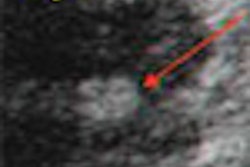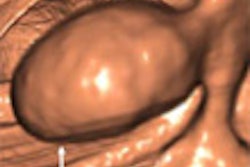Pulmonary embolism isn't ruled out nearly as often when indirect CT venography is added to standard CT pulmonary angiography, according to radiologists from New York-Presbyterian Hospital and Weill Medical College at Cornell University in New York City.
A study in the February issue of Radiology found that the combined imaging approach increased the detection of thromboembolic disease detection by 20% compared with CT pulmonary angiography alone.
"Pulmonary embolism is a well-recognized sequela of deep venous thrombosis (DVT) of the lower extremities," wrote Drs. Matthew Cham, David Yankelevitz, and Claudia Henschke. "Findings of studies have shown that inadequately treated DVT is associated with recurrent pulmonary embolism, several investigators have developed helical ... (CT) protocols that depict both pulmonary embolism and lower extremity DVT" (Radiology, February 2005, Vol. 234:2, pp. 591-594).
For the prospective study conducted from 1998 to 2001, the team documented the lengths of venous thrombi in 378 consecutive patients, and whether these patients, and an additional 1,212 consecutive patients, had pulmonary embolism. The cohort ranged in age from 18-99 years with 707 (44%) men (median age 64, mean age, 61) and 883 (56%) women (mean age 64, mean age 62), including 1,324 (83%) inpatients and 266 (17%) outpatients from the emergency department and outpatient setting, all of whom were referred for suspicion of clinical PE.
The patients underwent routine clinical care in addition to combined CT angiography and indirect CT venography, following administration of 140 mL of iohexol at 3 mL/sec. (Omnipaque 300, GE Healthcare Bio-Sciences, Little Chalfont, U.K.). After a scan delay of 28 seconds, a Hi-Speed Advantage CT/i scanner (GE Healthcare, Waukesha, WI) was used to acquire images from the diaphragm to the aortic arch (section width 3 mm, pitch 1.6:1). The pelvis was scanned from the iliac crest 120 seconds after the first scan was completed. Reconstruction for the CT pulmonary angiographic portion was performed at 1-mm intervals. Indirect CT venography was evaluated by using standard 10-mm-thick nonoverlapping images.
One of six experienced chest radiologists evaluated each study for thrombi, defined as "low-attenuating partial or complete intraluminal filling defects, surrounded by a high-attenuating ring of enhanced blood, and were seen on at lease two consecutive transverse images," the authors wrote. CTPA reconstructions were performed at 1-mm intervals, while indirect CT venography images were assessed by means of 10-mm-thick nonoverlapping images.
Results showed that PE was detected in 243 (15%) of 1,590 patients at CTPA, and DVT was found in 148 (9%) patients at indirect CT venography. The thrombi ranged in length from 2-81 cm, and measured 4 cm or less in 24% of patients.
"Thus, the addition of indirect CT venography to CT pulmonary angiography resulted in a 20% incremental increase in thromboembolic disease detection compared with that at CT pulmonary angiography alone (99% confidence interval: 17%, 23%).... Two (6%) of 33 patients had clots measuring 2 cm or less, six (18%) had clots measuring 3-4 cm, and 25 (76%) had clots measuring more than 4 cm in length," the group wrote. The results are consistent with previous studies showing increases of 15% to 38% with the combined exams, according to the authors.
The study requirement of visualizing filling defects on two consecutive sections was deemed a limitation due to the potential for clots 1 cm or smaller to be misdiagnosed. At the same time, filling defects seen on only one section might be attributed to partial volume averaging, they explained. Also, no standard comparisons were used in the study, though a previous study comparing indirect CT venography to ultrasound confirmed equivalent sensitivity and specificity.
Finally, radiation exposure to the pelvis and gonads is an important consideration when weighing the addition of indirect CT venography, the group cautioned. In an earlier study with similar protocols for combined CTPA and indirect CT venography, Rademaker and colleagues found patient gonadal doses ranging from 2.1-10.7 mSv, the researchers noted (Journal of Thoracic Imaging, October 2001, Vol. 16:4, pp. 297-299).
"Some investigators have found that the frequency of isolated pelvic DVT is relatively uncommon, comprising 1% to 4% of all cases positive for DVT. Thus, another possible imaging option would be to scan only the legs in patients who are in the reproductive age group," they wrote. Lower-dose imaging protocols that are now available could potentially simplify the decision as to whether the pelvic scan was warranted, the group concluded.
By Eric Barnes
AuntMinnie.com staff writer
February 1, 2005
Related Reading
Gonadal shield cuts scatter radiation from MDCT, January 10, 2005
MDCT detects PE incidentally, December 30, 2005
Biosite gets FDA clearance for pulmonary embolism diagnostic test, December 6, 2004
CT imaging alone may be suitable for work-up of pulmonary embolism, November 22, 2004
Thoracic CT expert takes on chronic PE diagnosis, October 15, 2004
CT for PE: Best test gets better, September 10, 2004
MDCT drives important changes in U.K. healthcare, August 10, 2004
Copyright © 2005 AuntMinnie.com



















